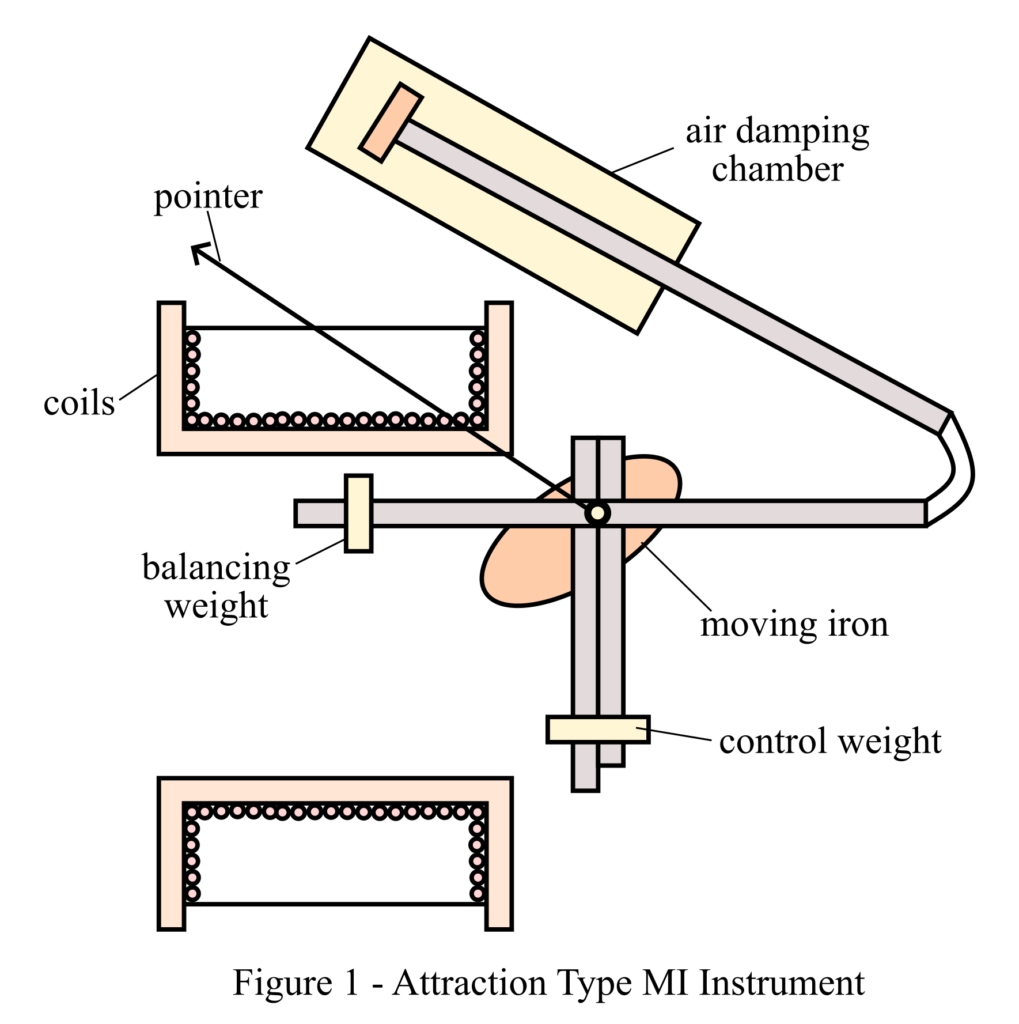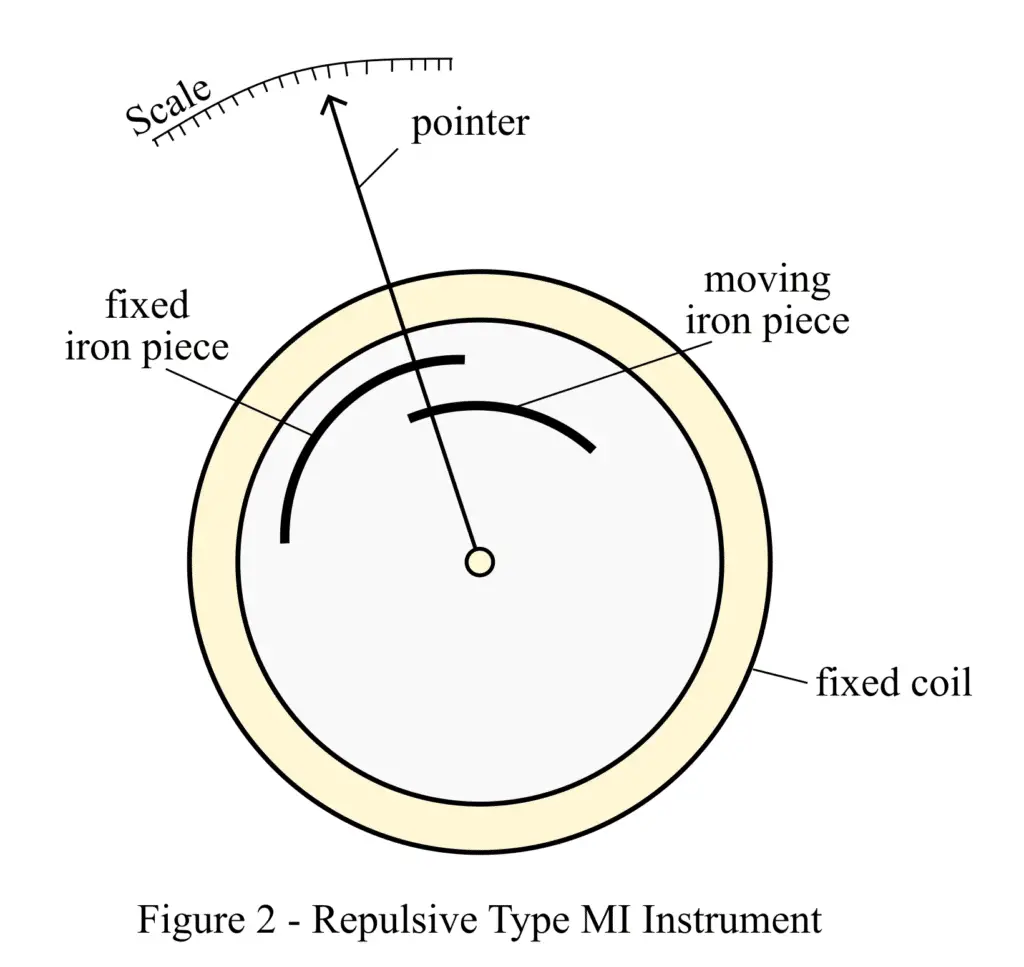Moving iron or MI instrument has a moving iron that measures the current and voltage. A wide range of measuring instruments are available these days that measure various electrical parameters such as current, resistance, voltage, power, etc. One such primitive measuring instrument is the – moving iron (MI) instrument.
This article describes the definition, construction, working principle, advantages, and disadvantages of moving iron instruments.
What is a Moving Iron Instrument?
A moving iron Instrument is a convenient measuring instrument used to determine the electric current flowing in a circuit, and the voltage across the connected electronic device or circuitry.
It performs the measurement by means of a moving-iron mechanism. According to this mechanism, a soft iron vane is kept in a region of the magnetic field produced by an electromagnet. Moreover, there is a pointer attached to the moving iron core that deflects based on the position of the soft iron vane. The position of the iron core is dependent on the strength of the magnetic flux surrounding it.
Construction of the Moving Iron Instrument
The main elements of a moving iron instrument, or measuring device are – a magnetized static coil and a soft iron core. The static coil is magnetized by passing an electric current through the conducting wires of the coil. Thus, the stationary coil behaves like an electromagnet. The iron core is placed close to the electromagnet. The iron vane is the moving part of the measuring device, that gets attracted towards the magnetic flux generated by the electromagnet.
The input current supplied to the static coil is the parameter to be measured by the instrument. In most cases, a pointer is attached to the soft iron vane, the pointer’s deflection depends upon the position of the iron core. The position of the iron core depends on the strength of the magnetic flux produced by the electromagnet. The strength of the magnetic field generated by the electromagnet is highly dependent on the current supplied to it. The greater the magnitude of the supply current, the greater the attraction of the iron core toward it.
Working of the Moving Iron Instrument
When an electric current pass through the static coil made up of copper or aluminum generates a magnetic field around it. Therefore, the magnetized stationary coil behaves like an electromagnet. A direct and linearly proportional relationship exists between the current flowing across the electromagnet and the magnetic field strength.
The inductivity of the static magnetized coil is incremented by the movement of the iron core across the stationary coil. Inductivity is defined as that property of a conductor which generates increased emf on passing currents of varying magnitudes.
The iron core is attracted by the electromagnet via the magnetic flux generated around it. A minimum reluctance path is established when the soft iron core gets attracted and moves toward the electromagnet. Reluctance is defined as the property of a conductor that resists the electric current flowing through it.
A repulsive force is experienced by the iron core that moves towards the electromagnet. As a result, the inductivity of the static coil increases due to the repulsive force generated. The repulse force is generated as a result of the reluctance and inductance being inversely proportional to each other.
Types of Moving Iron (MI) Instruments
Classifications of Moving Iron Instruments: There are mainly two categories of moving iron instruments namely – Attraction Type and Repulsion Type.
Attraction Type of Moving Iron Instrument

Figure 1 above demonstrates the working of an attractive type MI instrument. The static coil of the measuring instrument is comprised of a minute opening. The moving iron core gets attracted toward the magnetic field induced by the stationary coil. The strength of attraction of the iron core towards the electromagnet depends upon the magnetic field strength generated. A controlling torque is generated by means of a spring attached to the instrument. Additionally, an aluminum piston is also attached to the moving iron vane in order to minimize the fluctuation of the magnetized coil.
Repulsive Type of Moving Iron Instrument

Figure 2 above illustrates a repulsive type MI instrument. A repulsive type moving iron instrument is comprised of two iron cores. One of the iron cores is stationary, while the other iron core is movable. When the stationary iron core produces a magnetic field, both the iron cores get magnetized. Therefore, similar polarity is established on both iron coils.
As a result, repulsion occurs between both the vanes. Consequently, the pointer attached to the movable iron core moves across the scale, displaying the amount of current or voltage supplied to it. Air friction is also produced which in turn induces the damping torque. Due to its independency of the direction of current flow across it, repulsive instruments find their applications in measuring both AC and DC values of currents.
Advantages of Moving Iron Instrument
The merits of using a moving iron instrument are as follows.
- Low Cost – due to the less number of winding present in the stationary coil instrument, it is relatively cheap.
- Wide Operating Range- MI instruments have a wide range of operations for voltage and current measurement.
- Robust – Due to the simple design of the moving iron instrument and the static electromagnet present within the instrument, it is very efficient and robust.
- High Overload Capacity- They can withstand momentarily overloads without getting damaged. Therefore, these instruments can measure the transient currents and voltages.
- Linearity- MI instruments have good linearity in the measurements over a wide range. Therefore, they can measure the voltage and current precisely.
- Universal – due to the independency of the direction of current flow, it can be used for measuring both AC and DC currents.
Disadvantages of Moving Iron Instrument
The demerits of using a moving iron instrument are as follows.
- Precision – Although, MI instruments have linearity over a wide range. However, at extreme values, they have non-linearity in the measurement. Thus, the result obtained for extreme values of voltage and current is less accurate.
- Hysteresis Error- These instruments have hysteresis errors. Current flowing in different directions causes a magnetic reversal, and as a result, the hysteresis error creeps into the instrument.
- Limited Frequency Response- At higher frequencies, MI instruments have limited frequency response because the mechanical inertia of the instrument causes the instrument to slow response.
- Stray Magnetic Field- The useful flux when getting diverted and linked to other metallic parts of the instrument cause error in the measurement.
- Mechanical Wear and Tear- These instruments have mechanical parts which are inclined to wear and tear after a certain period of time.
- Environmental Influences- The external magnetic field can influence the measurement accuracy of the instrument.
- Waveform Error – Since the deflection torque is not proportional to the square of the current flowing through it, a waveform error occurs within the instrument.
Conclusion
In conclusion, in this article, we discussed how a moving iron instrument can be used to measure the current and voltage of circuits or machines connected to it in a conventional manner. Although the measurement method is relatively outdated, it is a relatively cheap, efficient, and robust method of measurement.